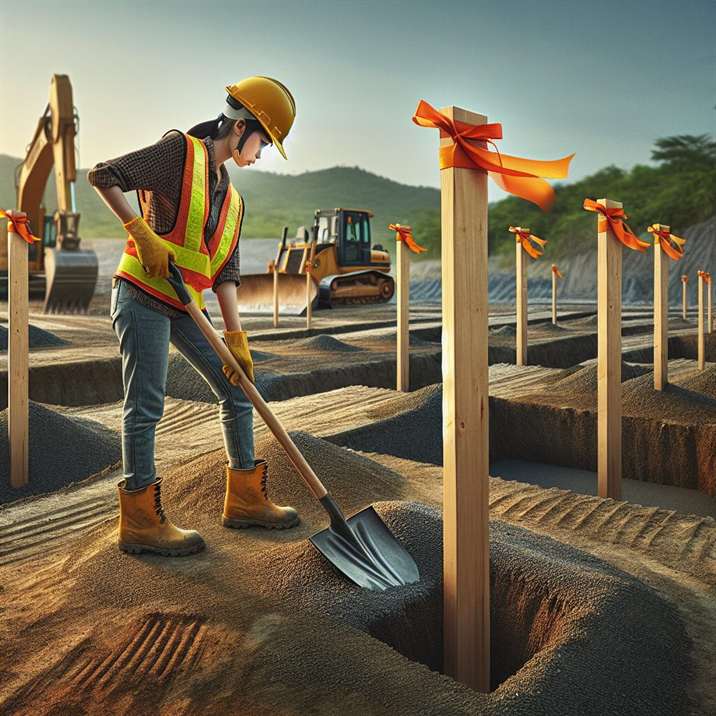Boundary Stakes and Lath: Defining Your Construction Project Lines
Introduction
Did you know that the right boundary stakes and lath can make or break your construction project? In the ever-evolving world of construction, the accuracy of project lines is crucial for ensuring efficiency and precision. With the growing complexity of construction projects today, the significance of using boundary stakes and lath has increased tremendously. These tools not only help in defining project lines but also play a vital role in project management.
In this comprehensive guide, we will explore the definition of boundary stakes and lath, how they work, their benefits, the challenges faced in their usage, and future trends within the construction industry. Understanding these elements can significantly enhance your project outcomes and streamline operations.
For a deeper understanding of how stake placement can influence project outcomes, check out our guide on construction layout stakes.
What is Boundary Stakes and Lath?
Definition of Boundary Stakes and Lath
Boundary stakes are wooden or metal markers used to define the perimeter of a construction site or specific project area. They serve as visual indicators for contractors, surveyors, and workers, ensuring that everyone is aligned on the project’s boundaries. Lath, on the other hand, refers to thin strips of wood used in conjunction with stakes to create a framework for marking layouts. Together, these tools form a system that helps maintain the integrity of the project’s design.
Historical Context
The use of boundary stakes and lath dates back centuries, with roots in traditional surveying practices. Historically, wooden stakes were the primary choice due to their availability and ease of use. Over time, advancements in materials and technology have led to the development of more durable options, including metal and composite stakes. The evolution of lath has similarly progressed, with modern lath being made from a variety of materials suitable for different construction needs.
The Importance of Boundary Stakes and Lath
In recent years, the importance of boundary stakes and lath has surged due to several factors:
- Increased Project Complexity: As construction projects grow in size and intricacy, the need for precise measurements and clear boundaries becomes paramount.
- Regulatory Compliance: Many regions mandate the use of boundary markers to adhere to zoning laws and property lines.
- Enhanced Collaboration: Clear demarcation of project lines fosters better communication and coordination among team members.
Boundary Stakes and Lath in the Context of Construction
In construction, these tools are integral to site preparation and layout. They ensure that structures are built according to the specified design and that all dimensions are accurate. Boundary stakes mark the corners and edges of the project site, while lath is often used for aligning walls, foundations, and landscaping elements.
Key Players or Contributors
The market for boundary stakes and lath has seen significant contributions from various companies specializing in construction materials. Innovations such as eco-friendly stakes and customizable lath options have emerged, catering to the changing demands of the construction industry.
For more insights, visit our page on the essential role of surveying stakes.

How Does Boundary Stakes and Lath Work?
The Mechanics of Boundary Stakes and Lath
The application of boundary stakes and lath involves a straightforward yet systematic approach:
- Site Surveying: Before placing stakes, a thorough survey of the site is conducted to determine the exact boundaries and layout.
- Stake Placement: Boundary stakes are driven into the ground at key points, typically at corners or changes in direction.
- Lath Alignment: Lath is then attached to the stakes, creating a visual reference for construction activities. This framework indicates where walls, fences, or other structures should be placed.
- Verification: Throughout the construction process, the alignment is checked regularly to ensure ongoing accuracy.
Technological Foundations of Boundary Stakes and Lath
Modern construction has benefited from technological advancements that enhance the effectiveness of boundary stakes and lath. Tools like laser levels and digital measuring devices allow for precise placement and adjustments, reducing human error. Additionally, materials used for stakes and lath have improved, with options now available that are resistant to rot, warping, and the elements, ensuring longevity and durability.
Challenges in Implementation
Despite their advantages, the use of boundary stakes and lath can present challenges:
- Environmental Factors: Weather conditions can affect the stability of stakes and lath, requiring regular checks and adjustments.
- Material Quality: The durability of the materials used can significantly impact the overall effectiveness of boundary marking.
- Skill Level: Proper placement and alignment require a certain level of skill and experience, which may not always be available on-site.
Best Practices for Using Boundary Stakes and Lath
To maximize the benefits of boundary stakes and lath, consider these best practices:
- Regular Training: Ensure that all team members are trained in the proper techniques for placing and using these tools.
- Quality Materials: Invest in high-quality stakes and lath that are appropriate for the specific construction requirements.
- Frequent Checks: Regularly verify the alignment and stability of stakes and lath throughout the project lifecycle.
For a comprehensive look at the benefits of using these tools, check out our article on Advantages of Construction Stakes & Lath.
Benefits of Boundary Stakes and Lath
Enhanced Accuracy and Precision
One of the primary advantages of utilizing boundary stakes and lath is the enhanced accuracy they provide. By establishing clear project lines, construction teams can ensure that all elements are built to the correct specifications. This reduces the risk of costly mistakes and rework, promoting overall project efficiency.
Cost-Effectiveness
Using these tools can lead to significant cost savings. By minimizing errors and ensuring that work is done right the first time, teams can avoid delays and additional expenditures. Furthermore, high-quality stakes and lath are often durable, reducing the need for frequent replacements.
Improved Communication
Boundary stakes and lath serve as visual aids that improve communication among team members. When everyone can see the defined project lines, it fosters a shared understanding of the scope and layout, enhancing collaboration and reducing misunderstandings.
Versatility in Application
Whether it’s for residential projects, commercial buildings, or landscaping, boundary stakes and lath are versatile tools that can be adapted to various construction needs. Their application extends beyond merely marking boundaries; they can also assist in defining levels, alignments, and even aesthetic elements in landscaping.
For more insights on choosing the right tools, read our guide on Select Top-Quality Fencing Stakes & Lath.
Future Trends in Boundary Stakes and Lath
Eco-Friendly Materials
As the construction industry increasingly emphasizes sustainability, there is a growing trend towards eco-friendly materials for boundary stakes and lath. Companies are developing products made from recycled and renewable resources, allowing for more sustainable construction practices.
Technological Integration
The integration of technology into the construction process is also shaping the future of boundary marking tools. Innovations such as smart stakes that can communicate with project management software or sensors that provide real-time data on placement accuracy are on the horizon.
Customization Options
With the demand for tailored solutions in construction, many manufacturers are now offering customizable stakes and lath. This allows contractors to select specific sizes, materials, and features that best suit their projects, enhancing overall efficiency and effectiveness.
Conclusion
In conclusion, boundary stakes and lath are indispensable tools in the construction industry, playing a crucial role in defining project lines and ensuring accuracy. Their evolution over time, coupled with advancements in technology and materials, has made them more effective than ever. By understanding their mechanics, benefits, and future trends, construction professionals can leverage these tools to optimize their projects.
For anyone involved in construction, whether you are a seasoned contractor or a novice, mastering the use of boundary stakes and lath can significantly impact your project outcomes. Explore more about how to effectively use these tools and enhance your construction efficiency by checking our article on Top Construction Tips: Stakes & Lath. Embrace the power of these tools, and watch your projects thrive.
By embedding the internal links naturally throughout the text, we enhance both the user experience and SEO performance of the article, making it a valuable resource for readers interested in construction practices.
Resource Links:
1. Boundary Markers – Comprehensive information on boundary stakes and lath, including their uses and installation techniques.
2. Lath and Stakes Co. – A resource for purchasing various types of lath and boundary stakes for construction and landscaping projects.
3. Landscaping Network – Articles and guides on using boundary stakes and lath in landscaping design and property demarcation.

